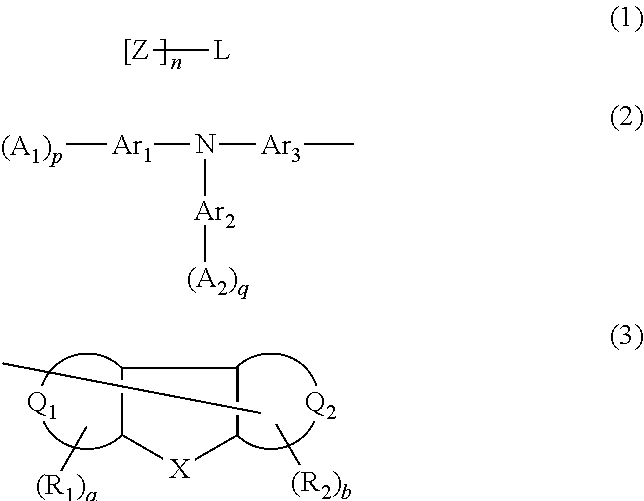Aromatic amine derivative, organic device material and hole-injection/transport material and organic electroluminescent element material each comprising the derivative, and organic electroluminescent element
a technology of organic electroluminescent elements and derivatives, which is applied in the direction of luminescent compositions, organic chemistry, thermoelectric devices, etc., can solve the problems of reducing the cost and growing the screen size, insufficient hole-transporting function (mobility), and insufficient solubility of coating solvents, etc., to achieve high hole mobility, high heat resistance, and amorphous
- Summary
- Abstract
- Description
- Claims
- Application Information
AI Technical Summary
Benefits of technology
Problems solved by technology
Method used
Image
Examples
synthesis example 1
Synthesis of Intermediate 1
[0223]Under a stream of argon, 47 g of 4-bromobiphenyl, 23 g of iodine, 9.4 g of periodic acid dehydrate, 42 ml of water, 360 ml of acetic acid and 11 ml of sulfuric acid were placed in a 1000 ml three-necked flask, stirred at 65° C. for 30 minutes, and reacted at 90° C. for 6 hours. The reactant was poured into iced water and filtrated. The resulting matter was washed with water and then methanol to obtain 67 g of white powder.
[0224]As a result of analysis of the white powder obtained using field desorption mass spectrometry (hereinafter referred to as FD-MS), the main peaks of m / z=358, 360 were obtained relative to C12H8BrI=359. Therefore, the white powder was identified as Intermediate 1.
synthesis example 2
Synthesis of Intermediate 2
[0225]The reaction was conducted in the same manner as in Synthesis Example 1 except that 2-bromo-9,9-dimethylfluorene was used instead of 4-bromobiphenyl to obtain 61 g of white powder.
[0226]The white powder obtained was identified as Intermediate 2 by the FD-MS analysis.
synthesis example 3
Synthesis of Intermediate 3
[0227]Under argon atmosphere, 2 ml of trans-1,2-cyclohexanediamine and 300 ml of 1,4-dioxane were added to 28.3 g of 4-iodobromobenzene, 16.7 g of carbazole, 0.2 g of copper iodide (CuI) and 42.4 g of tripotassium phosphate. The resulting mixture was stirred at 100° C. for 20 hours.
[0228]After completion of the reaction, 300 ml of water was added to the resultant and then separated to remove the aqueous layer. The organic layer was dried with sodium sulfate and then concentrated. The residue was purified by silica-gel column chromatography to obtain 18.3 g of white crystals.
[0229]The white crystals obtained were identified as Intermediate 3 by the FD-MS analysis.
PUM
 Login to View More
Login to View More Abstract
Description
Claims
Application Information
 Login to View More
Login to View More - R&D
- Intellectual Property
- Life Sciences
- Materials
- Tech Scout
- Unparalleled Data Quality
- Higher Quality Content
- 60% Fewer Hallucinations
Browse by: Latest US Patents, China's latest patents, Technical Efficacy Thesaurus, Application Domain, Technology Topic, Popular Technical Reports.
© 2025 PatSnap. All rights reserved.Legal|Privacy policy|Modern Slavery Act Transparency Statement|Sitemap|About US| Contact US: help@patsnap.com



